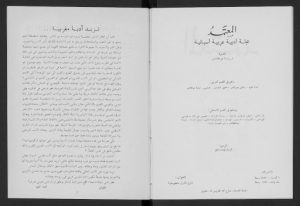Jack Clift is a doctoral researcher and translator affiliated with the Multilingual Locals, Significant Geographies (MULOSIGE) project.
Amina al-Luh, Nurīd adaban maghribīyyan…
We Want a Moroccan Literature

Al-Motamid 32, Tetouan 1955. Source: Spanish National Library.
Which of these literary schools of thought can we take as an example for our own literary existence, moving forward, in the light that it shines, to create our own literature? Do we stride on towards Lebanon, even as it walks its own path with a different set of travellers? Or do we turn towards Egyptian literature and risk, by doing so, becoming mere imitators, committing the same mistake once again?
I believe that these are not the only options open to us. All that we need to do is create a modern, Moroccan literature that gives our literature its own active character, a character that distinguishes our literature from other literatures and that leaves its own distinctive mark on it. We want to create a Moroccan literary school of thought that has the splendour and magnificence of our ancient heritage and the depth of thinking and loftiness of ideas of our modern legacy.
We want to rebel against contemporary literature and to lay the groundwork for a strong, solid literature that brings together the best qualities of the ancients and the moderns and that can be, when taken together, a Moroccan, Arabic literature, both in its spirit and in its ideas.
Are our writers willing, then, to piece our fragmented literature back together and to create a pure, Moroccan literary legacy?
—Amina al-Luh, Tetouan
Commentary
Notable here are the terms by which al-Luh delineates between the literatures of the Arab(ic-speaking) world and ‘foreign’ literature (al-adab al-faranjī); though originally used to refer specifically to the Franks, faranjī here can be taken to mean any ‘foreigner,’ a category that is further subdivided into the ‘Europeans’ (urūbī) who ‘wear Arab dress’ (alladhī yalbas al-badhla al-ʿarabīyya). But later, when talking about the literature of the ancient Arabs, al-Luh makes another – more temporally and geographically specific? – distinction when she refers to the ‘gibberish of the foreigners’ (raṭānat al-aʿājim) that, in her view, has come to ‘tarnish’ or ‘taint’ more recent Arabic writing. The aʿājim she alludes to here are more precisely non-Arabic speakers, especially Persians, who in older times were judged on the ‘barbarism’ of their speech and their perceived inability to speak Arabic well.
Another term to note here is ‘our literary revival’ or ‘renaissance’ (nahḍatunā al-adabīyya), which al-Luh suggests Morocco is currently undergoing (or perhaps will undergo, if Moroccan writers fully set their minds to it). The use of nahḍa here situates this Moroccan literary revival within – or against – the wider ‘Awakening’ or ‘Renaissance’ (the Nahda, frequently capitalised) in Arabic literature that had begun in the latter half of the nineteenth century. This was a literary and cultural ‘revival’ that, in traditional accounts, grew primarily out of the Ottoman-administered Mashriq, the eastern portions of the Arab world (principally Syria, Lebanon and Egypt), but also the Mahjar, the diasporic community of Arabic speakers who had emigrated, for the most part, from the Levant (Syria, Lebanon and Palestine) to the Americas at the end of the nineteenth century. Al-Luh’s use of the term here marks an equivalence between what has happened in the Mashriq and what she believes is happening, or can happen, in the Maghrib, the western part of the Arab(ic-speaking) world to which Morocco belongs.
This feeds into a broader tension in al-Luh’s writing, insofar as she frequently refers ‘our literature’ (adabunā) when it is ‘taken together’ or ‘collectively’ (mujtamaʿan or jamīʿan), while at the same taking great pains to delineate precisely between the literary traditions of particular parts of the Arab(ic-speaking) world. It is clear that she wants – demands – a particularly Moroccan literature, to be written in Arabic (which, in itself, has implications for the multilingual milieu of Morocco). But she also seems to see this a constituent part of a wider, pan-Arab (or pan-Arabic) literary tradition that is able to meld the precedents of the past with the ‘development of the modern age’ (taṭawwur al-ʿaṣr al-ḥadīth).


Leave A Comment